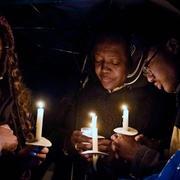
Tom Hanks: Skolor borde lära ut om massakern i Tulsa
Den amerikanske skådespelaren Tom Hanks tycker att massakern i Tulsa borde ingå i historieundervisningen i USA. Det skriver han i en personlig essä i The New York Times.
Hanks skriver att han är historiskt intresserad, men att han ”aldrig läst en enda sida i någon historiebok i skolan” om massakern för hundra år sedan då en mobb av vita personer dödade omkring 300 svarta amerikaner och fördrev tusentals från staden Tulsa i Oklahoma.
Tom Hanks tycker även att skolorna måste sluta framställa historiska skeenden i bättre dager för att undvika obehag för eleverna.
”Amerikas historia är rörig, men känner vi till den blir vi ett visare och starkare folk”, skriver han.
Läs mer
bakgrund
Massakern i Tulsa
Wikipedia (en)
The Tulsa race massacre took place on May 31 and June 1, 1921, when mobs of White residents, many of them deputized and given weapons by city officials, attacked Black residents and burned businesses of the Greenwood District in Tulsa, Oklahoma, US. Alternatively known as the Black Wall Street massacre or the Tulsa race riot, it marks one of "the single worst incident(s) of racial violence in American history". The attack, carried out on the ground and from private aircraft, destroyed more than 35 square blocks of the district – at that time the wealthiest Black community in the United States, known as "Black Wall Street".More than 800 people were admitted to hospitals, and as many as 6,000 Black residents were interned in large facilities, many of them for several days. The Oklahoma Bureau of Vital Statistics officially recorded 36 dead. A 2001 state commission examination of events was able to confirm 39 dead, 26 Black and 13 White, based on contemporary autopsy reports, death certificates and other records. The commission gave several estimates ranging from 75 to 300 dead.The massacre began during the Memorial Day weekend after 19-year-old Dick Rowland, a Black shoeshiner, was accused of assaulting Sarah Page, the 17-year-old White elevator operator of the nearby Drexel Building. He was taken into custody. After the arrest, rumors spread through the city that Rowland was to be lynched. Upon hearing reports that a mob of hundreds of White men had gathered around the jail where Rowland was being kept, a group of 75 Black men, some of whom were armed, arrived at the jail in order to ensure that Rowland would not be lynched. The sheriff persuaded the group to leave the jail, assuring them that he had the situation under control. A shot was fired, and then, according to the reports of the sheriff, "all hell broke loose." At the end of the firefight, 12 people were killed: 10 White and 2 Black. As news of these deaths spread throughout the city, mob violence exploded. White rioters rampaged through the Black neighborhood that night and the next morning, killing men and burning and looting stores and homes. Around noon on June 1, the Oklahoma National Guard imposed martial law, effectively ending the massacre.
About 10,000 Black people were left homeless, and property damage amounted to more than $1.5 million in real estate and $750,000 in personal property (equivalent to $32.65 million in 2020). Many survivors left Tulsa, while Black and White residents who stayed in the city kept silent about the terror, violence, and resulting losses for decades. The massacre was largely omitted from local, state, and national histories.
In 1996, 75 years after the massacre, a bipartisan group in the state legislature authorized the formation of the Oklahoma Commission to Study the Tulsa Race Riot of 1921. The commission's final report, published in 2001, states that the city had conspired with the mob of White citizens against Black citizens; it recommended a program of reparations to survivors and their descendants. The state passed legislation in order to establish scholarships for the descendants of survivors, encourage the economic development of Greenwood, and develop a park in memory of the victims of the massacre in Tulsa. The park was dedicated in 2010. In 2020, the massacre became a part of the Oklahoma school curriculum.
Omni är politiskt obundna och oberoende. Vi strävar efter att ge fler perspektiv på nyheterna. Har du frågor eller synpunkter kring vår rapportering? Kontakta redaktionen
